1994 CHEVROLET CAVALIER check engine
[x] Cancel search: check enginePage 198 of 243
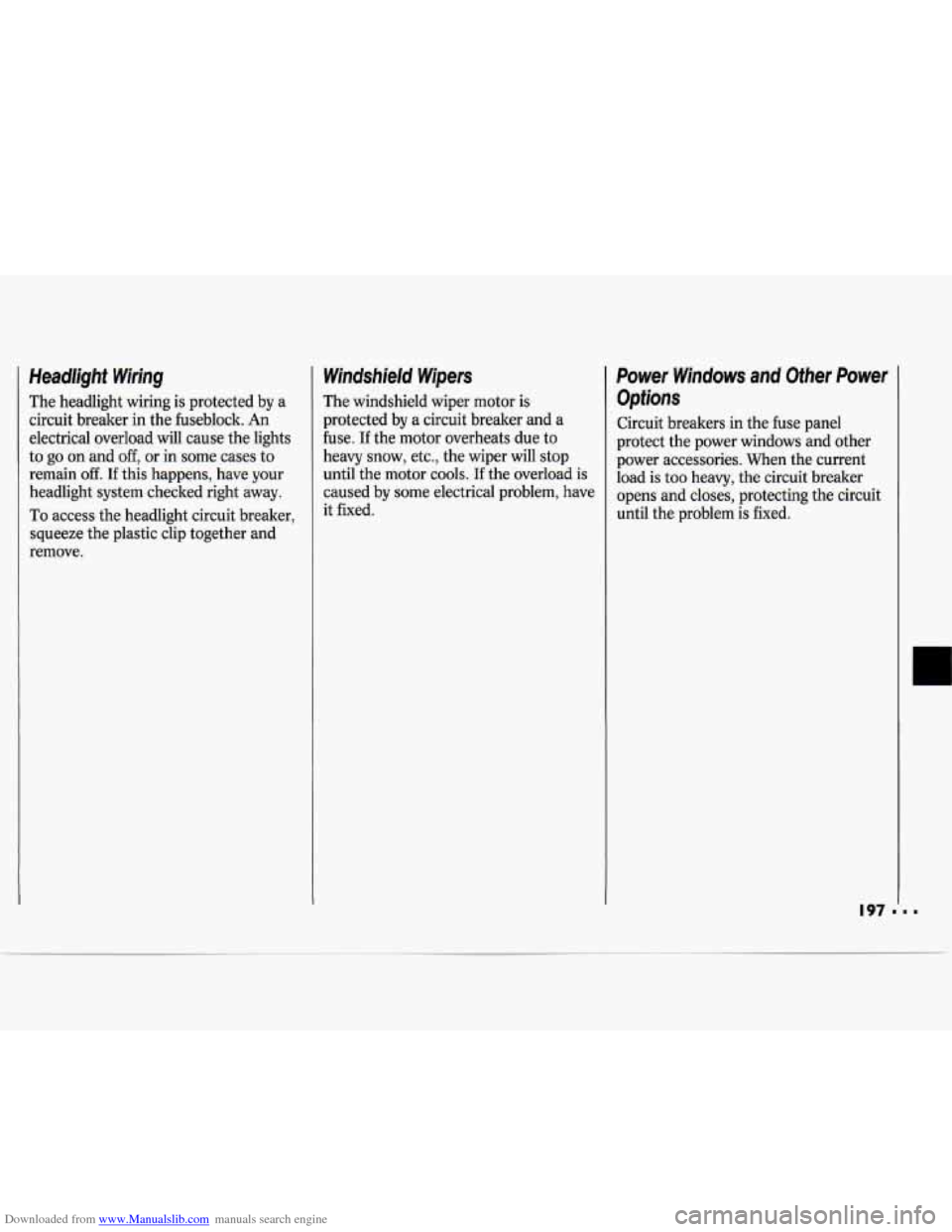
Downloaded from www.Manualslib.com manuals search engine Headlight Wiring
The headlight wiring is protected by a
circuit breaker in the fuseblock. An
electrical overload will cause the lights
to go on and off, or in some cases
to
remain off. If this happens, have your
headlight system checked right away.
To access the headlight circuit breaker,
squeeze the plastic clip together and
remove.
Windshield Wipers
The windshield wiper motor is
protected by
a circuit breaker and a
fuse. If the motor overheats due to
heavy snow, etc., the wiper will stop
until the motor cools.
If the overload is
caused by some electrical problem, have
it fixed.
Power Windows and Other Power
Options
Circuit breakers in the fuse panel
protect the power windows and other
power accessories. When the current
load is too heavy, the circuit breaker
opens and closes, protecting the circuit
until the problem is fixed.
Page 204 of 243
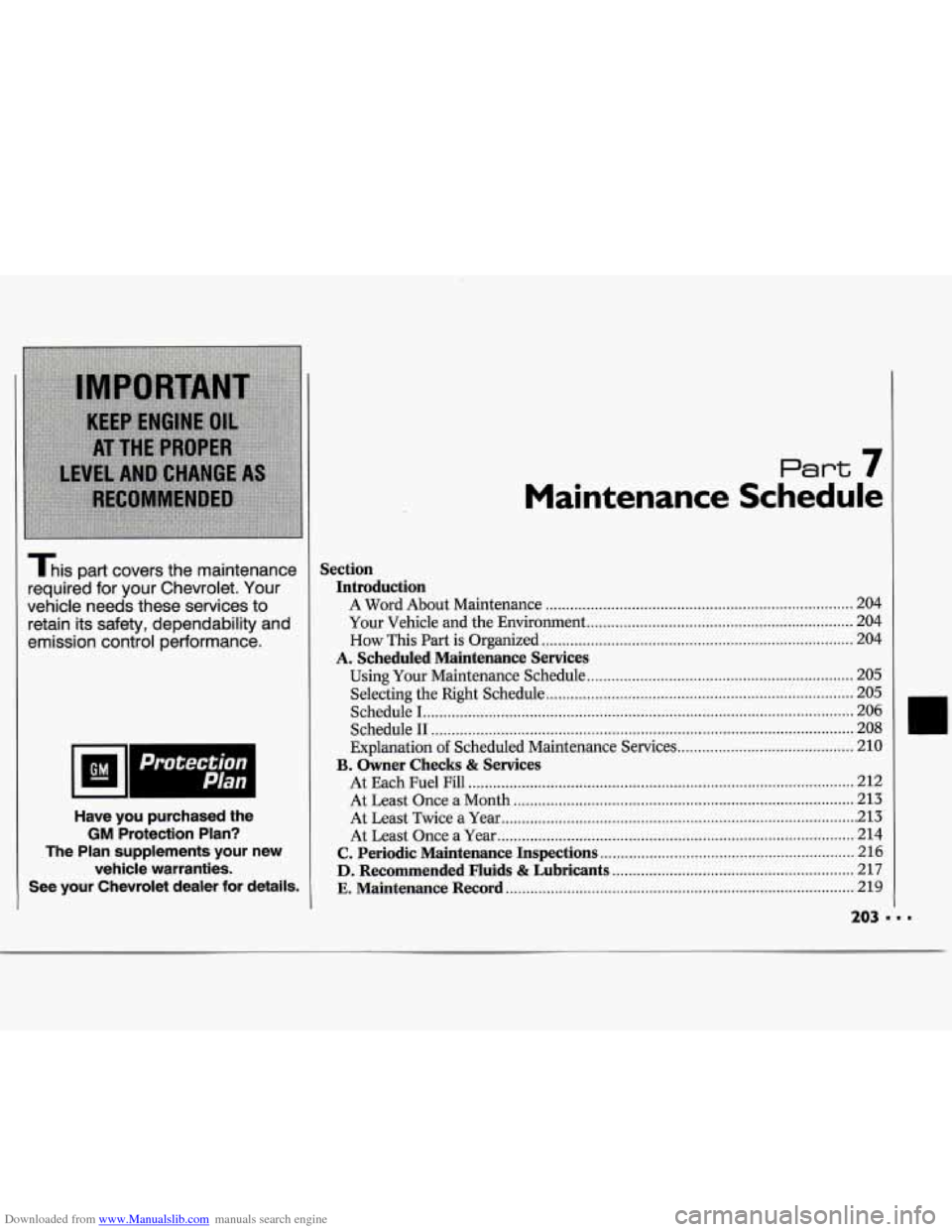
Downloaded from www.Manualslib.com manuals search engine This part covers the maintenance
required for your Chevrolet
. Your
vehicle needs these services to
retain its safety. dependability and
emission control performance
.
Have you purchased the
GM Protection Plan?
The Plan supplements your new vehicle warranties
.
See your Chevrolet dealer for details .
Part 7
Maintenance Schedule
Section Introduction
A Word About Maintenance ........................................................................\
... 204
Your Vehicle and the Environment
................................................................. 204
How This Part is Organized ........................................................................\
.... 204
Using Your Maintenance Schedule
................................................................. 205
A . Scheduled Maintenance Services
Selecting the Right Schedule ........................................................................\
... 205
Schedule
I ........................................................................\
................................. 206
Schedule
I1 ........................................................................\
............................... 208
Explanation of Scheduled Maintenance Services ........................................... 210
At Each Fuel Fill
........................................................................\
...................... 212
At Least Once a Month
........................................................................\
........... 213
At Least Twice a Year
........................................................................\
............... 213
At Least Once a Year
........................................................................\
............... 214
C . Periodic Maintenance Inspections .............................................................. 216
D . Recommended Fluids & Lubricants ........................................................... 217
E . Maintenance Record ........................................................................\
............. 219
B . Owner Checks & Services
203 1 I.
Page 205 of 243
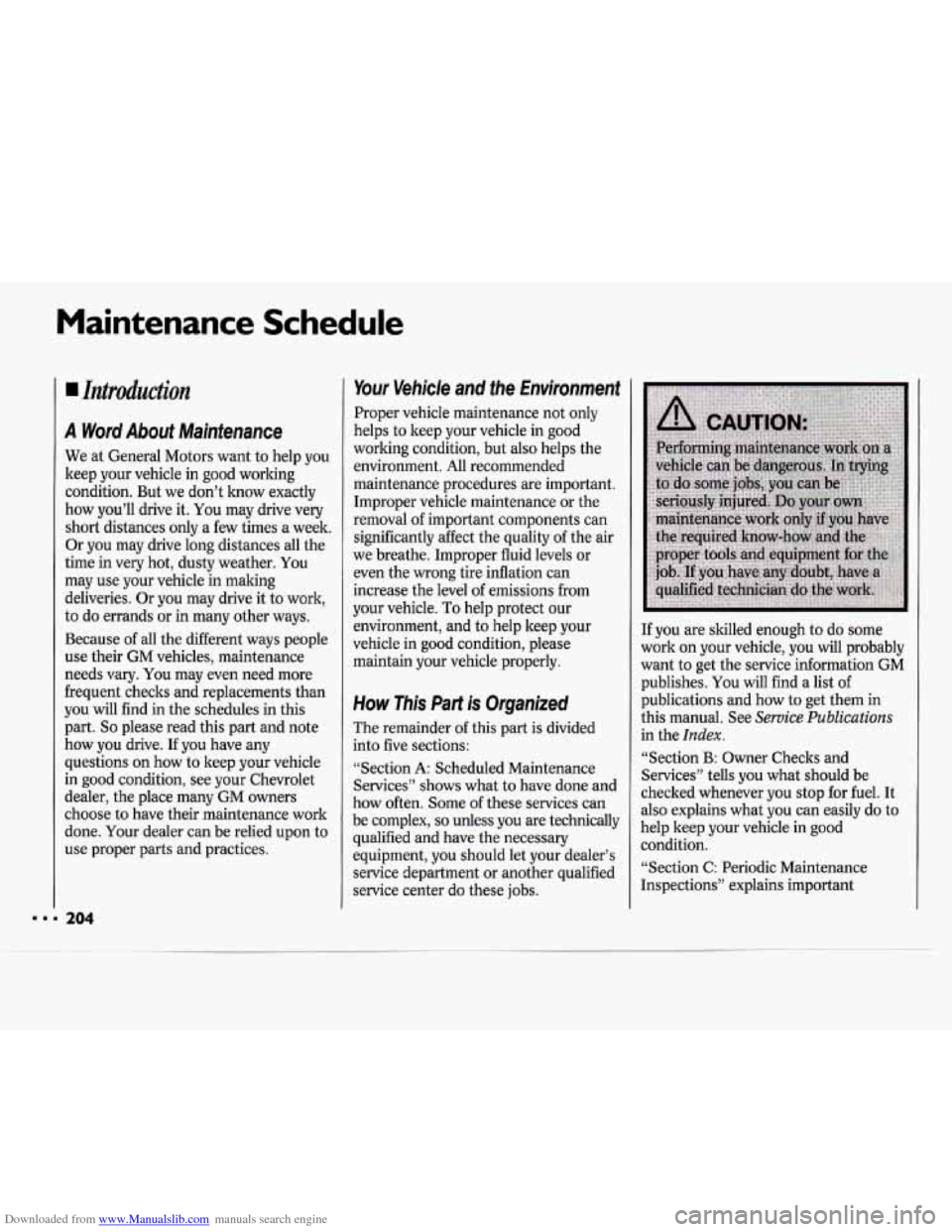
Downloaded from www.Manualslib.com manuals search engine Maintenance Schedule
BB
A Word About Maintenance
We at General Motors want to help you
keep your vehicle in good working
condition. But we don’t know exactly
how you’ll drive it. You may drive very
short distances only a few times a week.
Or you may drive long distances all the
time in very hot, dusty weather. You
may use your vehicle in malting
deliveries. Or you may drive it to work,
to do errands
or in many other ways.
Because of all the different ways people
use their GM vehicles, maintenance
needs vary. You may even need more
frequent checks and replacements than
you will find in the schedules in this
part.
So please read this part and note
how you drive. If you have any
questions on how to keep your vehicle
in good condition, see your Chevrolet
dealer, the place many
GM owners
choose to have their maintenance work
done. Your dealer can be relied upon to
use proper parts and practices.
204
Your Vehicle and the Environment
Proper vehicle maintenance not only
helps to keep your vehicle in good
working condition, but also helps the
environment. All recommended
maintenance procedures are important.
Improper vehicle maintenance or the
removal of important components can
significantly affect the quality of the air
we breathe. Improper fluid levels or
even the wrong tire inflation can
increase the level
of emissions from
your vehicle.
To help protect our
environment, and to help keep your
vehicle in good condition, please
maintain your vehicle properly.
How This Part is Organized
The remainder of this part is divided
into five sections:
“Section A: Scheduled Maintenance
Services” shows what to have done and
how often. Some
of these services can
be complex,
so unless you are technically
qualified and have the necessary
equipment, you should let your dealer’s
service department or another qualified
service center do these jobs. If
you are skilled enough to do some
work on your vehicle, you will probably
want to get the service information GM
publishes. You will find a list of
publications and how
to get them in
this manual. See
Service Publications
in the Index.
“Section B: Owner Checks and
Services” tells you what should be
checked whenever you stop for fuel. It
also explains what you can easily do to
help keep your vehicle in good
condition.
“Section
C: Periodic Maintenance
Inspections” explains important
Page 211 of 243
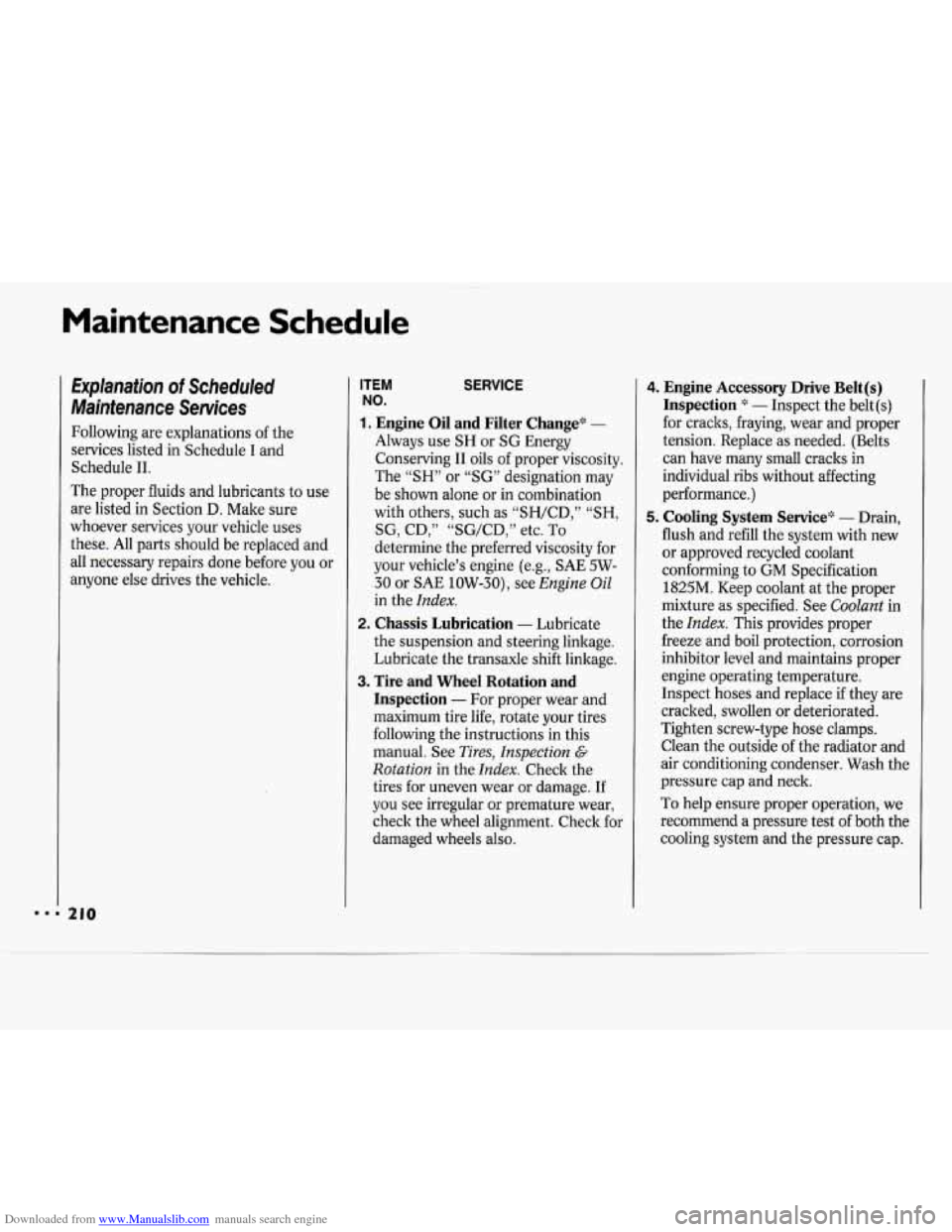
Downloaded from www.Manualslib.com manuals search engine Maintenance Schedule
Explanation of Scheduled
Maintenance Services
Following are explanations of the
services listed in Schedule
I and
Schedule 11.
The proper fluids and lubricants to use
are listed in Section
D. Make sure
whoever services your vehicle uses
these. All parts should be replaced and
all necessary repairs done before you or
anyone else drives the vehicle.
ITEM SERVICE
NO.
1. Engine Oil and Filter Change* -
Always use SH or SG Energy
Conserving I1 oils of proper viscosity.
The
“SH” or “SG” designation may
be shown alone or in combination
with others, such as “SH/CD,”
“SH,
SG, CD,” “SG/CD,” etc. To
determine the preferred viscosity for
your vehicle’s engine (e.g., SAE 5W-
30 or SAE 10W-30), see
Engine Oil
in the Index.
the suspension and steering linkage.
Lubricate the transaxle shift linkage.
Inspection - For proper wear and
maximum tire life, rotate your tires
following the instructions in this
manual. See
Tires, Inspection G
Rotation in the Index. Check the
tires for uneven wear or damage. If
you see irregular or premature wear,
check the wheel alignment. Check for
damaged wheels also.
2. Chassis Lubrication - Lubricate
3. Tire and Wheel Rotation and
4. Engine Accessory Drive Belt(s)
Inspection
* - Inspect the belt (s)
for cracks, fraying, wear and proper
tension. Replace as needed. (Belts
can have many small cracks in
individual ribs without affecting
performance.)
5. Cooling System Service* - Drain,
flush and refill the system with new
or approved recycled coolant
conforming to
GM Specification
1825M. Keep coolant at the proper
mixture as specified. See
Coolant in
the
Index. This provides proper
freeze and boil protection, corrosion
inhibitor level and maintains proper
engine operating temperature.
Inspect hoses and replace if they are
cracked, swollen or deteriorated.
Tighten screw-type hose clamps.
Clean the outside of the radiator and
air conditioning condenser. Wash the
pressure cap and neck.
To help ensure proper operation, we
recommend a pressure test
of both the
cooling system and the pressure cap.
Page 212 of 243
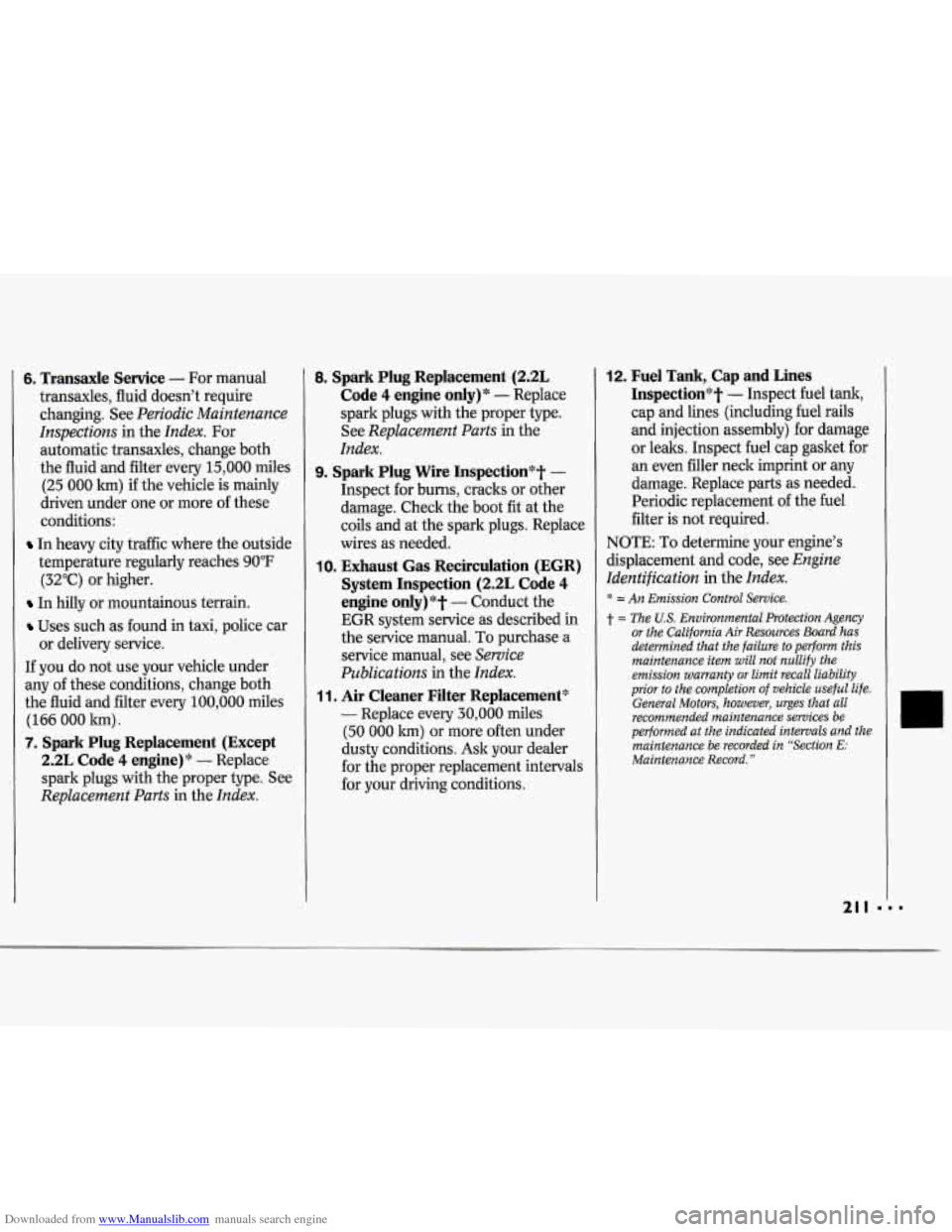
Downloaded from www.Manualslib.com manuals search engine 6, Transaxle Service - For manual
transaxles, fluid doesn’t require
changing. See
Periodic Maintenance
Inspections
in the Index. For
automatic transaxles, change both
the fluid and filter every 15,000 miles
(25
000 km) if the vehicle is mainly
driven under one or more of these
conditions:
In heavy city traffic where the outside
temperature regularly reaches 90°F
(32°C) or higher.
In hilly or mountainous terrain.
Uses such as found in taxi, police car
If you do not use your vehicle under
any of these conditions, change both
the fluid and filter every 100,000 miles
(166
000 lun).
7. Spark Plug Replacement (Except
2.2L Code
4 engine)* - Replace
spark plugs with the proper type. See
Replacement Parts in the Index.
or delivery service.
8. Spark Plug Replacement (P.2L
Code 4 engine only)* - Replace
spark plugs with the proper type.
See
Replacement Parts in the
Index.
9. Spark Plug Wire Inspection*t -
Inspect for burns, cracks or other
damage. Check the boot
fit at the
coils and at the spark plugs. Replace
wires as needed.
IO. Exhaust Gas Recirculation (EGR)
System Inspection (2.2L Code
4
engine only)*? - Conduct the
EGR system service as described
in
the service manual. To purchase a
service manual, see
Service
Publications
in the Index.
1 1. Air Cleaner Filter Replacement*‘
- Replace every 30,000 miles
(50
000 km) or more often under
dusty conditions. Ask your dealer
for the proper replacement intervals
for your driving conditions.
12. Fuel Tank, Cap and Lines
Inspection’#t
- Inspect fuel tank,
cap and lines (including fuel rails
and injection assembly) for damage
or leaks. Inspect fuel cap gasket for an even filler neck imprint or any
damage. Replace parts as needed.
Periodic replacement of the fuel
filter is not required.
NOTE: To determine your engine’s
displacement and code, see
Engine
Identification
in the Index.
* = An Emission Control Service.
t = The U.S. Environmental Protection Agency
or the California Air Resources Board has
determined that the failure to perform this
maintenance item will not nullify the
emission warranty
or limit recall liability
prior to the completion of vehicle useful life.
General Motors, however, urges that all
recommended maintenance services be
performed at the indicated intervals and the
maintenance be recorded in “Section
E:
Maintenance Record.”
Page 213 of 243
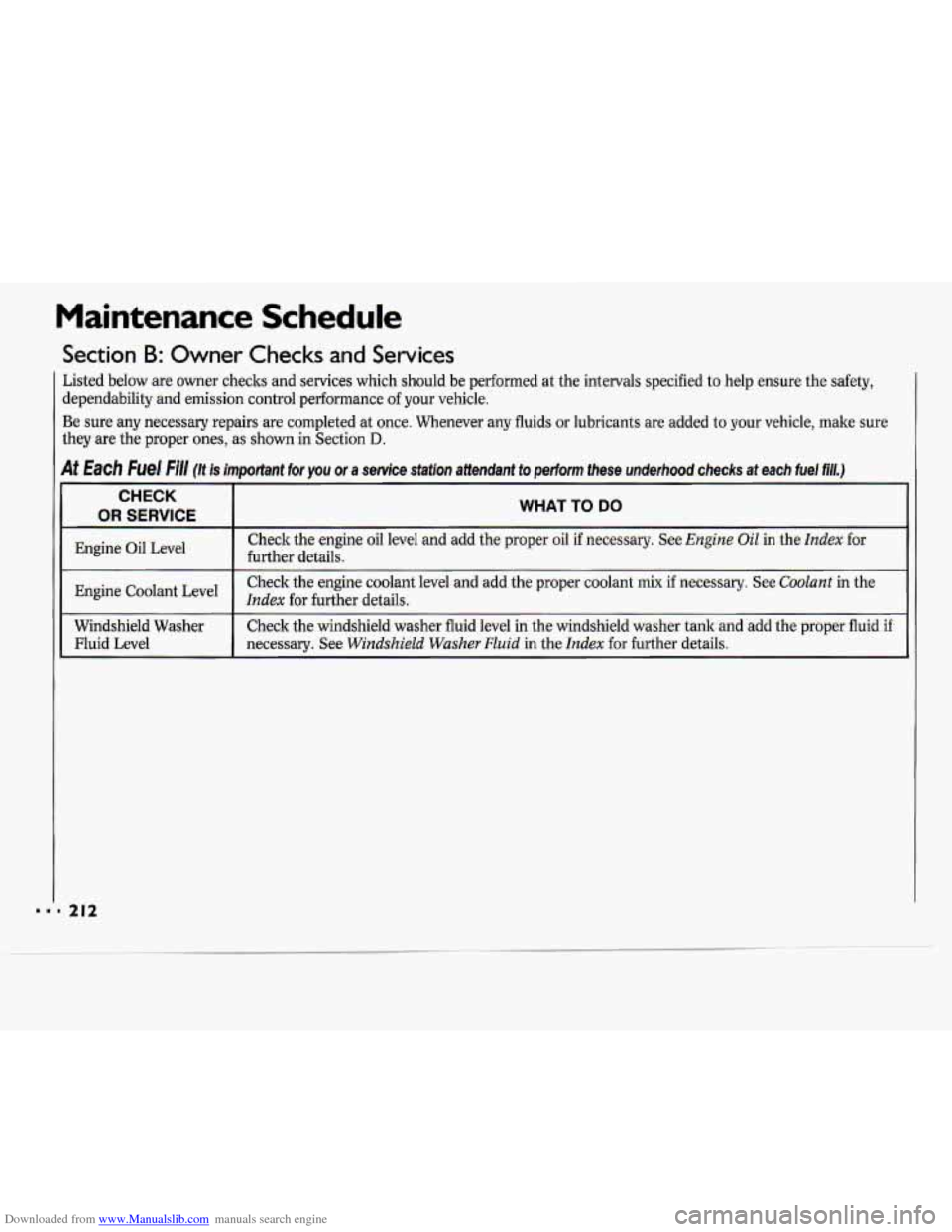
Downloaded from www.Manualslib.com manuals search engine Maintenance Schedule
Section B: Owner Checks and Services
hted below are owner checks and services which should be performed at the intervals specified to help ensure the safety,
lependability and emission control performance of your vehicle.
3e sure any necessary repairs are completed at once. Whenever any fluids or lubricants are added to your vehicle, make sure
hey are the proper ones, as shown in Section
D.
Each he/ (It is important for you or a service station attendant to perform these underhood checks at each fuel fill.)
CHECK
OR SERVICE I WHAT TO DO
Engine Oil Level
I
Check the engine oil level and add the proper oil if necessary. See Engine Oil in the Index for
further details.
I
Check the engine coolant level and add the proper coolant mix if necessary. See Coolant in the
Engine Index for further details.
Windshield Washer Check the windshield washer fluid level in the windshield washer tank and add the proper fluid if
Fluid Level necessary. See
Windshield Washer Fluid in the Index for further details. 1
Page 214 of 243
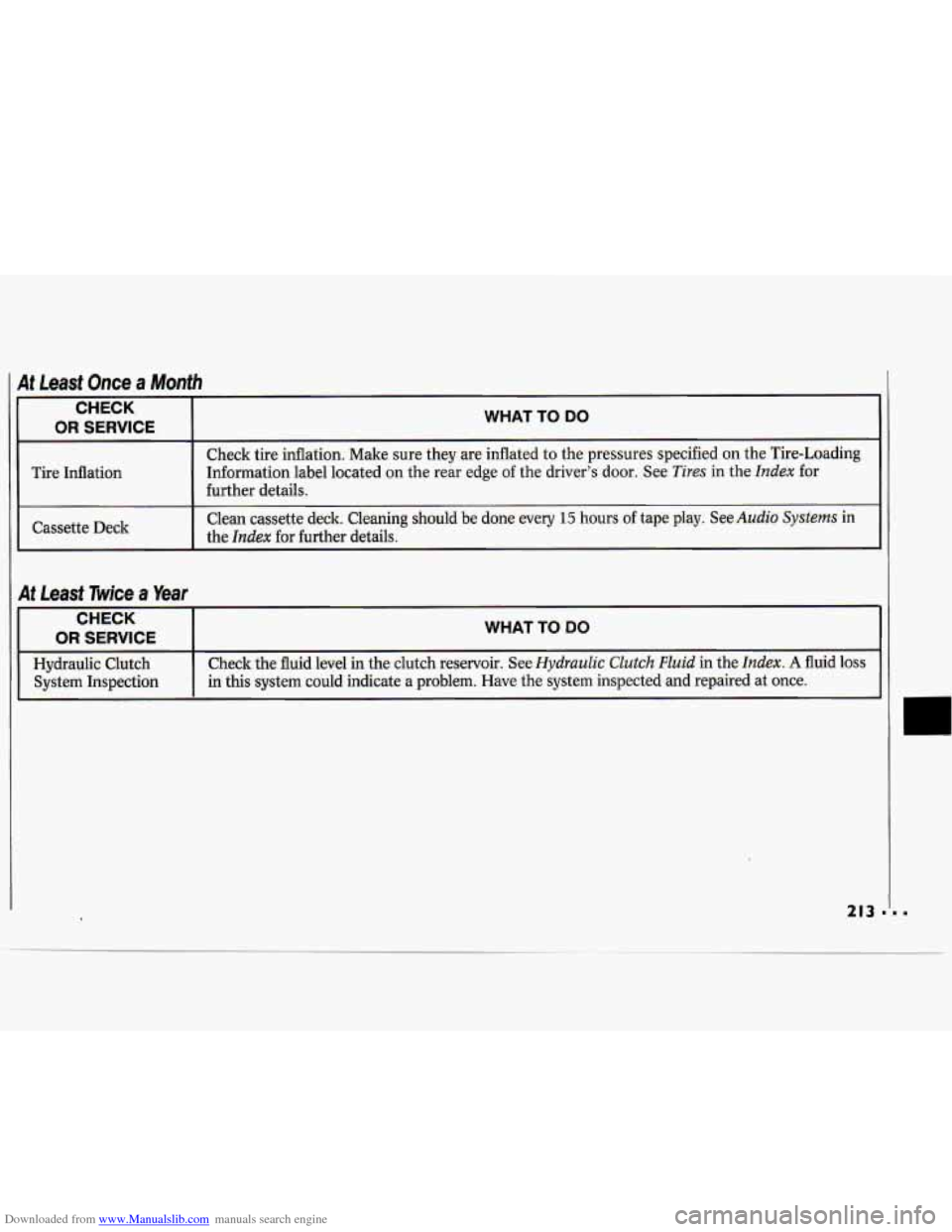
Downloaded from www.Manualslib.com manuals search engine CHECK
OR SERVICE WHAT TO DO
Check tire inflation. Make sure they are inflated to the pressures specified on the Tire-Loading
further details. Clean cassette deck. Cleaning should be done every
15 hours of tape play. See Audio Systems in
the
Index for further details.
Tire Inflation
Information label located on the rear edge of the driver’s door. See
Tires in the Index for
Cassette Deck
At Least Twice a Year
CHECK
OR SERVICE WHAT TO DO
Hydraulic Clutch Check
the fluid level in the clutch reservoir. See Hydraulic CZutch Huid in the Index. A fluid loss
System Inspection in this system could indicate a problem. Have the system inspected and repaired at once.
213 I.
Page 215 of 243
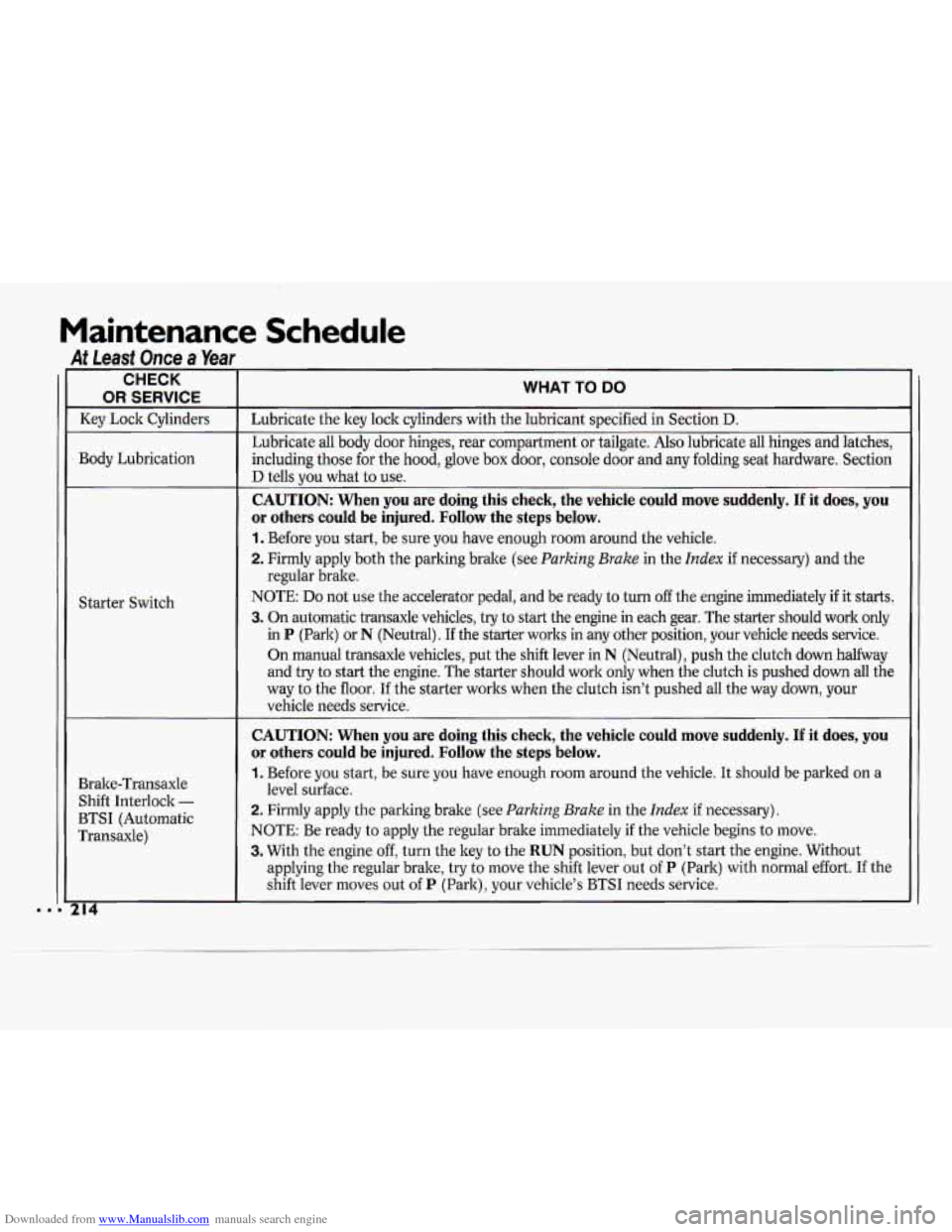
Downloaded from www.Manualslib.com manuals search engine Maintenance Schedule
At Leasf Once a Year
CHECK
-
-
-
OR SERVICE
Key Lock Cylinders
Body Lubrication
Starter Switch
Bralte-Transaxle Shift Interlock
-
BTSI (Automatic
Transaxle)
- z A
WHAT TO DO
Lubricate the key lock cylinders with the lubricant specified in Section D.
Lubricate all body door hinges, rear compartment or tailgate. Also lubricate all hinges and latches,
including those for the hood, glove box door, console
door and any folding seat hardware. Section
D tells vou what to use.
CAUTION: When you are doing this check, the vehicle could move suddenly. If it does, you
or others could be injured. Follow the steps below.
1. Before you start, be sure you have enough room around the vehicle.
2. Firmly apply both the parking brake (see Parking Brake in the Index if necessary) and the
NOTE:
Do not use the accelerator pedal, and be ready to turn off the engine immediately if it starts.
3. On automatic transaxle vehicles, try to start the engine in each gear. The starter should work only
in
P (Park) or N (Neutral). If the starter worlts in any other position, your vehicle needs servic\
e.
On manual transaxle vehicles, put the shift lever in
N (Neutral), push the clutch down halfway
and try to start the engine. The starter should work only when the clutch is pushed down all the
way to the floor.
If the starter worlts when the clutch isn’t pushed all the way down, your
vehicle needs service. regular
brake.
CAUTION: When you are doing this check, the vehicle could move\
suddenly. If it does, you
or others could be injured. Follow the steps below.
1. Before you start, be sure you have enough room around the vehicle. It should be parked on a
2. Firmly apply the parking brake (see Parking Brake in the Index if necessary),
NOTE: Be ready to apply the regular brake immediately if the vehicle begins to move.
3. With the engine off, turn the key to the RUN position, but don’t start the engine. Without
level surface.
applying the regular brake, try to move the shift lever out of
P (Park) with normal effort. If the
shift lever moves out of
P (Park), your vehicle’s BTSI needs service.